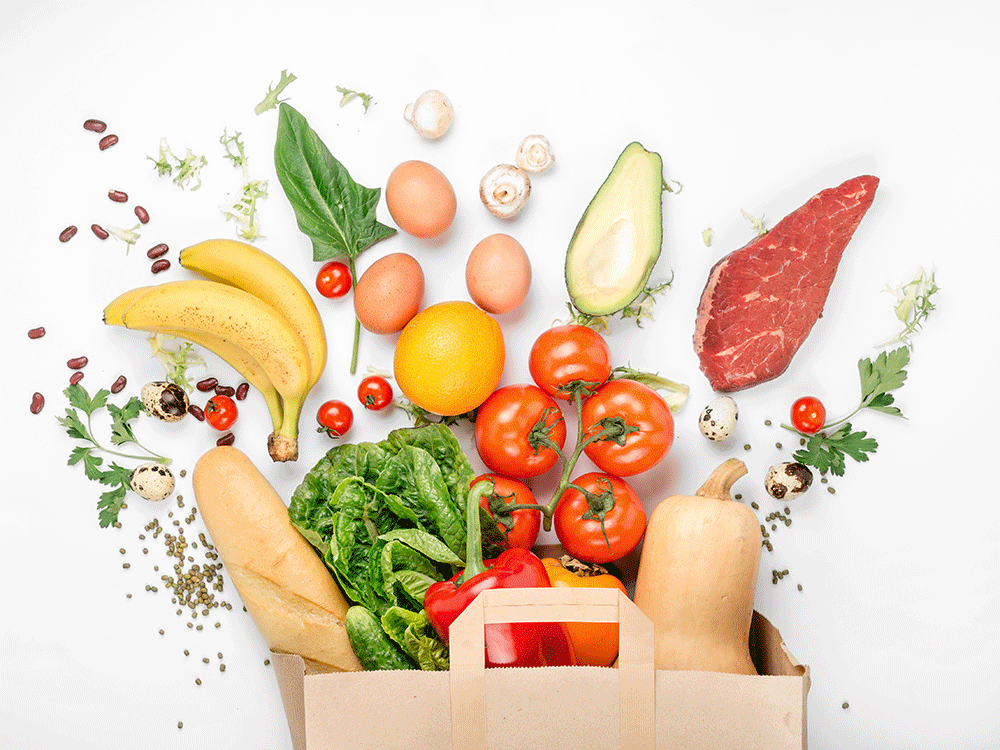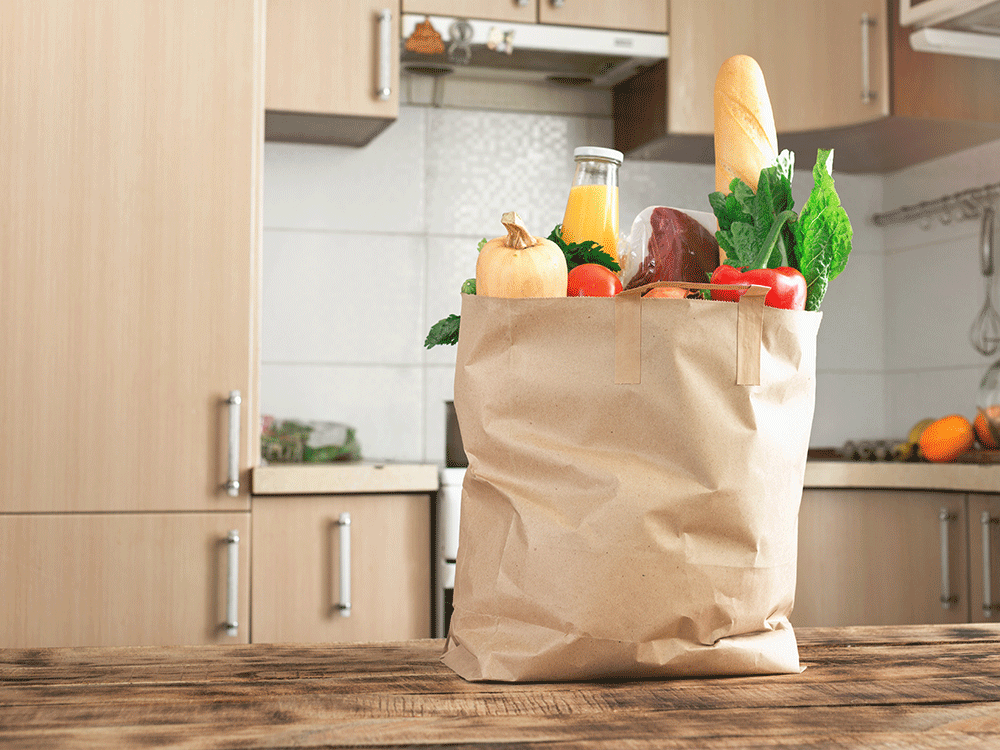
The Challenge: Save 25 Per Cent on Food
The condominium complex where we used to live, in a north Toronto suburb, had a single chute for waste. As a family, we were diligent recyclers, but we paid little attention to our kitchen scraps. Bags filled with wrappers, eggshells and leftovers were pushed past the door and forgotten. When we decided to move to a new home in early 2016, however, our garbage became harder to ignore.
During one bad week, my family threw out most of a carton of blueberries, a half rack of ribs, rice, baked potatoes and an unopened tray of chicken that had developed a pungent odour—in addition to leftover food from our plates and a picky toddler’s untouched dinner. In total, we tossed about $40 worth of food.
I’m the resident shopper and chef, so the onus is on me. We’re so consistent in what fills our grocery basket—chicken, diced tomatoes, broccoli, asparagus, green beans—that I can often guess the total before it’s rung through: typically $115 a week. (My wife and I usually buy lunches at work; otherwise, we eat most meals at home.) It adds up to about $6,000 a year for our family of four.
This didn’t seem like a problem—until we tracked our waste. On too many occasions, our fridge was full of half-used onions, spoiled cucumbers, rotten lemons and mouldy cheeses—all orphan ingredients from slapdash meals dreamed up on the fly.
We’re not alone. At the University of Guelph, assistant professor Kate Parizeau was part of a research team that audited the city’s residential food waste in the summer of 2014. They cracked open green bins and learned that the average family generated 4.5 kilograms of food waste every week. Of that, roughly 2.3 kilograms were avoidable, while another half-kilogram was considered to be possibly avoidable. (The latter category includes items that some people would consider consuming, while others wouldn’t—bread crusts, for instance, or carrot and potato peels that could be used for stock.) “We were picking up green bins that had been outside for between one and seven days, and some of the food still looked pretty edible,” she says.
According to research by Ralph Martin, a professor at the University of Guelph and the school’s former Loblaw Chair in Sustainable Food Production, that 4.5 kilograms of food is equal to about $31 each week, or $1,616 a year. The average Canadian family of four spends roughly $153 a week on food, which means about 20 per cent of our grocery purchases end up in the bin. (That figure doesn’t include the cost of eating out, which, for the typical household, adds up to about $2,200 per year.) It’s about as much as many families spend annually on gas.
Of course, inflation and the weak loonie have also driven up supermarket bills, as have unusual price fluctuations. According to a recent poll by the Vancouver-based Angus Reid Institute, 57 per cent of Canadians say it’s becoming more of a challenge to put food on the table. Moreover, 61 per cent of us have reduced our meat consumption and 42 per cent have cut back on fruits and vegetables.
But how much sacrifice is necessary to save a buck? I consulted chefs, nutritionists and food experts for guidance. With their advice, by shopping smarter and reducing waste over six weeks, I aimed to cut our $6,000 annual grocery bill by $1,500—or 25 per cent. I found that with a bit of planning, not only can my family eat great for less, we can eat even better than before.

1. Make Proper Portions
According to a 2010 Canadian review, well-run restaurants waste no more than five per cent of their food. I set out to find someone who could keep costs in check but still cook a great meal. My search led me to Suzanne Barr, the chef and owner behind Saturday Dinette, a modern 35-seat diner in a trendy east-end area of Toronto.
When Barr noticed that many plates were coming back with an untouched buckwheat pancake during brunch, she quickly reduced the serving from three flapjacks to two.
Adjusting portions works well at home, too. Author and registered dietitian Cara Rosenbloom suggests that parents serve their kids smaller amounts, offering seconds if they’re still hungry. Few people would save food that’s been picked over by a toddler, but with the right portioning, leftovers can be kept for another day.
Restaurants also make an effort to work with everything. “That’s how we really keep costs down: we use every part of the vegetable,” says Amanda Cohen, the Ottawa-born chef behind the lauded vegetarian restaurant Dirt Candy in New York City. “Even if they’re going bad, we’ll pickle or dehydrate them.”
When fennel arrives at Saturday Dinette, Barr mixes it into her slaw, uses the fronds for fennel butter and incorporates the rest into her stock. “It’s about getting the most out of every single thing here,” she says. And if the foods can’t be incorporated on the plate right away, there are options. “Turn a loaf of bread into bread crumbs,” suggests Barr. “Challenge yourself to make something you’ve never made before.”
Hungry for more content? Check out the 10 Things You Should Never, Ever Order at Brunch, According to Chefs

2. Buy Fewer Groceries, More Often
In North America, many of us snap up perceived deals by buying in bulk. Those supersized ketchup jugs and pickle jars are intended to save money, but they often end up creating more waste.
A 2014 University of Arizona study looked at shoppers who stocked up at low-priced retailers such as Walmart and found that they rarely consider the dollar value of what gets thrown out. One participant who bought salad greens at Costco for “$3.50 or something” discarded a portion but still felt it was a better deal than buying a smaller container of greens for $2.50. “The modern American tendency to shop infrequently is at odds with basic human abilities to predict future food consumption needs,” was what the author concluded.
A 2000 report out of the University of Illinois titled “The Mystery of the Cabinet Castaway” noted that as much as 15 per cent of the non-perishables in our pantries aren’t used and eventually get tossed. North Americans have grown accustomed to overfilling their fridges. My freezer is packed with packages of ice-encrusted meat, some of which have been with us for months. This frustrates Barr. Her rule: make sure things are coming out as often as they’re going in.
To combat that urge to stockpile, Cohen endorses the notion of shopping more often and for less stuff. “It’s better to shop twice a week than to shop once and have a whole fridge of food go bad,” she says. Until recently, she operated out of an 18-seat restaurant where a lean budget wasn’t just commended—it was a matter of survival. “We bought our vegetables every day. We never had leftovers at the end of the night. We always started fresh,” she says. “It really meant that we were using what we were buying, and that stuck with us at the new place.”
Though I worried it might be a logistical nightmare, I adopted her technique on our weekly shopping trip. We bought only what we needed to get through the weekend, cut down our meat purchases (which might have added an additional $30) and replenished throughout the week. To my surprise, the bill was a mere $40. The additional mid-week trip, for fresh vegetables, only added another $10 or so—which meant we’d shaved $65 off our weekly bill. If we did this one or more times per month, we’d reduce our yearly supermarket spending by nearly $1,000.

3. Don’t Sweat the Seasonal Stuff
Cohen’s business is built on turning common vegetables into high art, but she doesn’t shell out for organic carrots. She’s never gone out of the way to buy top-of-the-line fruits and vegetables, opting instead for the produce most of us have in our home kitchens.
Cohen feels consumers get too caught up in the notion of buying locally and in-season. While she agrees it’s great to support local farmers, most of our food comes from elsewhere. For instance, she says, “oranges are always out of season in Canada.”
I assumed certain foods would be cheapest during the months they’re grown in abundance. But after studying the Canadian consumer price index, which measures monthly changes in the cost of a fixed basket of goods in this country, I found otherwise. I observed some interesting trends over two decades of data: oranges are typically cheapest during the first three months of the year; apples are usually priciest during August and September, when they’re in season in Ontario. According to Kelly Ciceran, a general manager with Ontario Apple Growers, demand outstrips supply during those months.
Meanwhile, you can save by buying misshapen fruit and vegetables at any time. Loblaw Companies Ltd. latched onto this idea in 2015, when it launched its Naturally Imperfect line of produce in stores across the country, selling undersized, discoloured or strange-looking onions, apples, carrots and mushrooms for up to 30 per cent less than unblemished items.

4. Frozen Can Be Just as Healthy as Fresh, if Not More
The nutritionists I consulted urged me to visit the freezer aisle. As Rosenbloom explains, studies—including a 2015 report in the Journal of Agricultural Food and Chemistry—show that frozen products are just as fresh as refrigerated produce. “The frozen ones often have a higher nutrient content,” she says.
The journey from field to grocery store is a long one, and vitamins, such as vitamin C, break down over time. A bunch of fresh spinach might spend a week or more in transit, while its icy counterpart is typically flash frozen within six to 12 hours of being picked at peak freshness, she says.
Inspired by Rosenbloom, I picked up a two-kilogram bag of frozen broccoli from Costco for $10 and calculated that it contained about 20 servings. A few days later, I noticed a single stalk of limp broccoli, enough for two portions, selling for $2 at my local supermarket.
When fresh produce costs are high, or if you want backup veggies for when you may not have time to cook, the freezer section will cut costs and waste. But beware: not every frozen food item is a bargain. Fresh strawberries, for instance, are almost always a better deal. It’s only after they top $4.99 per pound that it pays to buy frozen.

5. Disregard Best-Before Dates
Most of us toss items based on the best-before info on the package. But University of Guelph associate professor Mike von Massow argues that our fixation on these numbers is misplaced. That printed info denotes when manufacturers estimate the food will be at peak freshness, he explains. Most of the time, the food is still good. In his opinion, it comes down to a judgment call: if it looks and smells fine, it probably is fine.
For paranoid folks like me, websites such as StillTasty can tell you how long you can keep that open jar of salsa (one month for varieties that don’t come already refrigerated); how long you can freeze maple syrup (indefinitely); and how long that tub of yogurt should last past its sell-by date (seven to 10 days, apparently). Just make sure to employ proper food-storage practices (as directed on the package), and resist the urge to crack open a fresh tub of sour cream just because the other one has already been open for a few days.

6. Consider Adopting Meatless Mondays
Meats add heft to a grocery bill. Beef is particularly pricey these days: according to Statistics Canada, the price of sirloin steak has risen nearly 12 per cent since 2014. Even if you eschew vegetarian options, you can lower your costs. One option: consider buying bone-in, skin-on chicken. You can debone it at home or cook it as is. With boneless, you’re paying extra for convenience.
Pulses—beans, lentils and chickpeas—can be used to help bulk up dishes so you can use less meat. Taking Rosenbloom’s recommendation, I added cooked lentils to sloppy joes, as well as meatloaf, and was pleased to note that it stretched our ground beef by adding at least two extra meals. Each of those dinners would have cost $1.73 per person in meat alone, but bolstering with lentils dropped the protein cost to $1.03—a savings of 40 per cent, which, over a year, could add up to $700. Not a bad return for a fraction of a $6, two-kilogram bag of lentils.
Tofu is another cost-effective substitute in recipes that call for boneless chicken breast. “For $2.99 total, you can feed a family of four,” says Rosenbloom. I recalled something Barr mentioned when I visited her at the diner: use an ingredient several ways to get the most out of it. For instance, one of her menus featured beets three times.
At home, that meant adding bean curd to our menu for two straight days. As someone who eats meat three times a day, I wasn’t enticed by the prospect, but I tossed extra-firm tofu cubes in a pan with caramelized butter. In minutes, I had a simple stir-fry that was surprisingly good and filling. A similar meal using chicken would have cost upwards of $9; this was less than $3 in total, and we had leftovers for lunch. Plus we wound up using the extra protein for a successful fried-rice experiment the next day. The whole family now looks forward to Tofu Thursdays.
Want to make a good impression? Here are 10 Polite Ways to Eat Sushi, Wings and Other Tricky Foods

Mission Achieved!
My goal was to disrupt my routine to find where I was wasting money. It was a challenge, but integrating these pro tips was fairly simple and worth the effort. By my calculations, they have the potential to save me as much as $1,500 over a year. Few households will ever be as smoothly and efficiently run as a restaurant, but even if you adopt just a few of these recommendations, you’ll save cash.
© 2016 Rogers Publishing Ltd. “Spend Less, Eat Better,” by Mark Brown, from MoneySense (June 2016), moneysense.ca